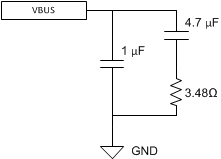ZHCSMU5A July 2020 – December 2020 TPS25814
PRODUCTION DATA
- 1 特性
- 2 应用
- 3 说明
- 4 Revision History
- 5 Pin Configuration and Functions
-
6 Specifications
- 6.1 Absolute Maximum Ratings
- 6.2 ESD Ratings
- 6.3 Recommended Operating Conditions
- 6.4 Recommended Capacitance
- 6.5 Thermal Information
- 6.6 Power Supply Characteristics
- 6.7 Power Consumption
- 6.8 PP_5V Power Switch Characteristics
- 6.9 Power Path Supervisory
- 6.10 CC Cable Detection Parameters
- 6.11 CC VCONN Parameters
- 6.12 Thermal Shutdown Characteristics
- 6.13 Input/Output (I/O) Characteristics
- 6.14 BC1.2 Characteristics
- 6.15 I2C Requirements and Characteristics
- 6.16 Typical Characteristics
- 7 Parameter Measurement Information
-
8 Detailed Description
- 8.1 Overview
- 8.2 Functional Block Diagram
- 8.3 Feature Description
- 8.4 Device Functional Modes
- 9 Application and Implementation
- 10Power Supply Recommendations
- 11Layout
- 12Device and Documentation Support
- 13Mechanical, Packaging, and Orderable Information
9.2.1.1.3 VBUS Snubber Circuit
 Figure 9-2 VBUS Snubber
Figure 9-2 VBUS SnubberAnother method of clamping the USB Type-C VBUS is to use a VBUS RC Snubber. An RC Snubber is smaller than a TVS diode, and typically more cost effective as well. An RC Snubber works by modifying the characteristic of the total RLC response in the USB Type-C cable hot-plug from being under-damped to critically-damped or over-damped. So rather than clamping the overvoltage directly, it changes the hot-plug response from under-damped to critically-damped, so the voltage on VBUS does not ring at all; so the voltage is limited, but without requiring a clamping element like a TVS diode.
However, the USB Type-C and Power Delivery specifications limit the range of capacitance that can be used on VBUS for the RC snubber. VBUS capacitance must have a minimum 1 µF and a maximum of 10 µF. The RC snubber values chosen support up to 4 m USB Type-C cable (maximum length allowed in the USB Type-C specification) being hot plugged, is to use 4.7-μF capacitor in series with a 3.48-Ω resistor. In parallel with the RC Snubber a 1-μF capacitor is used, which always ensures the minimum USB Type-C VBUS capacitance specification is met. This circuit is shown in Figure 9-2.